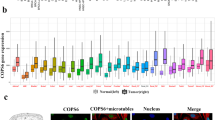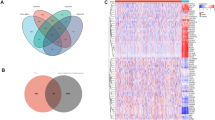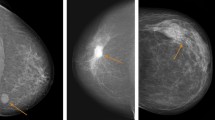Summary
Multifunctional cytokines play important and only partially defined roles in mammary tumour development and progression. Normal human mammary epithelial cells constitutively produce interleukin 6 (IL-6), IL-8 and a non-secreted form of tumour necrosis factor. Transformation of mammary epithelial cells by different oncogenes is frequently associated with alterations of cytokine/growth factor production and responsiveness. In the present study we analysed the expression of IL-6 in 149 cases of invasive breast carcinoma and the data have been correlated with clinico-pathological variables including tumour size, histological grade, nodal status, and oestrogen and progesterone receptors, Ki67 and p53, protein expression. Though the majority of breast carcinomas expressed at least low levels of immunoreactive IL-6, we found that expression of this cytokine was inversely associated with histological tumour grade (P = 0.0017), but not with tumour size and nodal status. Ki67 positivity was inversely correlated with IL-6 expression (P = 0.027). Among biological parameters analysed, a direct association was found between the percentage of IL-6-positive cells and that of oestrogen (P = 0.00005) and progesterone (P = 0.025) receptor-positive cells. No correlation was observed between IL-6 and p53 protein expression. These data indicate that down-regulation of IL-6 is associated with highly malignant mammary carcinomas. It will be of interest to evaluate whether alterations of cytokines that are constitutively produced by mammary cells are also associated with high-grade tumours.
Similar content being viewed by others
Article PDF
Change history
16 November 2011
This paper was modified 12 months after initial publication to switch to Creative Commons licence terms, as noted at publication
References
Allione, A., Consalvo, M., Nanni, P., Lollini, P. L., Cavallo, F., Giovarelli, M., Forni, M., Gulino, A., Colombo, M. P., Dellabona, P., Hock, H., Blankestein, T., Rosenthal, F. M., Gansbacher, B., Bosco, M. C., Musso, T., Gusella, L. & Forni, G. (1994). Immunizing and curative potential of replicating and nonreplicating murine mammary adenocarcinoma cells engineered with interleukin (IL) -2, IL-4, IL-6, IL-7, IL-10, tumor necrosis factor alpha, granulocyte-macrophage colony-stimulating factor, and gamma-interferon gene or admixed with conventional adjuvants. Cancer Res 54: 6022–6026.
Basolo, F., Conaldi, P. G., Fiore, L., Calvo, S. & Toniolo, A. (1993a). Normal breast epithelial cells produce interleukin 6 and 8 together with tumor-necrosis factor: defective IL-6 expression in mammary carcinoma. Int J Cancer 55: 1–5.
Basolo, F., Calvo, S., Fiore, L., Conaldi, P. G., Falcone, V. & Toniolo, A. (1993b). Growth-stimulating activity of interleukin 6 (IL-6) on human mammary epithelial cells transfected with the int-2 gene. Cancer Res 53: 2957–2960.
Basolo, F., Fiore, L., Calvo, S., Falcone, V., Conaldi, P. G., Fontanini, G., Caligo, A. M., Merlo, G., Gluzman, Y. & Toniolo, A. (1996a). Defective IL-6 expression and responsiveness in human mammary cells transformed by an adeno-5/sv40 hybrid virus. Br J. Cancer 73: 1356–1361.
Basolo, F., Fiore, L., Fontanini, G., Conaldi, P. G., Calvo, S., Falcone, V. & Toniolo, A. (1996b). Expression of interleukin 6 (IL-6) and response to it in human mammary tumours. Cancer Res 56: 3118–3122.
Basolo, F., Fiore, L., Pollina, L., Fontanini, G., Conaldi, P. G. & Toniolo, A. (1998). Reduced expression of interleukin 6 in undifferentiated thyroid carcinoma: in vitro and in vivo studies. Clin Cancer Res 4: 381–387.
Campani, D., De Negri, F., Martini, L., Giani, C., Squartini, F. & Sarnelli, R. (1991). Estrogen, progesterone receptors and proliferating activity evaluated by immunocytochemistry in breast cancer. Int J Biol Markers 6: 144–150.
Castelli, C., Sensi, M., Lupetti, R., Mortarini, R., Panceri, P., Anichini, A. & Parmiani, G. (1994). Expression of interleukin 1α, interleukin 6, and tumour necrosis factor α genes in human melanoma clones is associated with that of mutated N-ras oncogene. Cancer Res 54: 4785–4790.
Chen, I., Mory, Y., Zilberstein, A. & Revel, M. (1988). Growth inhibition of human breast carcinoma and leukemia/lymphoma cell lines by recombinant interferon-β. Proc Natl Acad Sci USA 85: 8037–8041.
Chiu, J. J., Sgagias, M. K. & Cowan, K. H. (1996). Interleukin 6 acts as a paracrine growth factor in human mammary carcinoma cell lines. Clin Cancer Res 2: 215–221.
Contesso, G., Mouriesse, H., Friedman, S., Genin, J., Sarrazin, D. & Rouesse, J. (1987). The importance of histologic grade in long-term prognosis of breast cancer: a study of 1010 patients, uniformly treated at the Institut Gustave Roussy. J Clin Oncol 5: 1378–1386.
Danforth, D. N. & Sagias, M. K. (1993). Interleukin-1 alpha and interleukin-6 act additively to inhibit growth of MCF-7 breast cancer cells in vitro. Cancer Res 53: 1538–1545.
Gandour-Edwards, R., Kapadia, S. B., Gumerlock, P. H. & Barnes, A. L. (1995a). Immunolocalization of interleukin-6 in salivary gland tumors. Hum Pathol 26: 501–503.
Gandour-Edwards, R., Kapadia, S. B., Janecka, I. P., Martinez, A. J. & Barnes, L. (1995b). Biological markers of invasive pituitary adenomas involving the sphenoid sinus. Mod Pathol 8: 160–164.
Garver, R. I., Radford, D. M., Donis-Keller, H., Wick, M. R. & Milner, P. G. (1994). Midkine and pleiotrophin expression in normal and malignant breast tissue. Cancer 74: 1584–1590.
Hirano, T. (1994). Interleukin-6. In The Cytokine Handbook, Thomson A (ed), pp. 145–168. Academic Press: London
Horne, G. M., Anderson, J. J., Tiniakos, D. G., McIntosh, G. G., Thomas, M. D., Angus, B., Henry, J. A., Lennard, T. W. J. & Horne, C. H. W. (1996). p53 protein as a prognostic indicator in breast carcinoma: a comparison of four antibodies for immunohistochemistry. Br J Cancer 73: 29–36.
Hug, H. (1997). Fas-mediated apoptosis in tumor formation and defense. Biol Chem 378: 1405–1412.
Keane, M. M., Ettemberg, S. A., Lowrey, G. A., Russel, E. K. & Lipkowitz, S. (1996). Fas expression and function in normal and malignant breast cell lines. Cancer Res 56: 4791–4798.
Lu, C. & Kerbel, R. S. (1993). Interleukin-6 undergoes transition from paracrine growth inhibitor to autocrine stimulator during human melanoma progression. J Cell Biol 120: 1281–1288.
Margulies, L. & Sehgal, B. (1993). Modulation of the Interleukin-6 promoter (IL-6) and transcription factor C/EBPb /NF-IL-6) activity by p53 species. J Biol Chem 268: 15096–15100.
Massagué, J., Cheifetz, S., Laiho, M., Ralph, D. A., Weis, F. M. B. & Zentella, A. (1992). Transforming growth factor-β. In Tumor Suppressor Genes, the Cell Cycle and Cancer, Levine AJ (ed), pp. 81–103. Cold Spring Harbor Laboratory Press: Cold Spring Harbor, NY
Michiel, D. F. & Oppenheim, J. J. (1992). Cytokines as positive and negative regulators of tumor promotion and progression. Semin Cancer Biol 3: 3–15.
Porter, J. K. & Lippman, M. E. (1994). Overview of the biologic markers of breast cancer. Hematol Oncol Clin North Am 8: 73–100.
Ray, A. & Prefontaine, K. E. (1994). Physical association and functional antagonism between the p65 subunit of transcription factor NF-kappa B and the glucocorticoid receptor. Proc Natl Acad Sci USA 91: 752–756.
Reed, M. J., Coldham, N. G., Patel, S. R., Ghilcchick, M. W. & James, V. H. T. (1992). Interleukin-1 and interleukin-6 in breast cyst fluid: their role in regulating aromatase activity in breast cancer cells. J Endocrinol 132: R5–R8.
Rosen, P. P. & Oberman, H. A. (1993). Tumors of the mammary gland. In Atlas of Tumor Pathology, Rosai J (ed), pp. 7–10. Armed Forces Institute of Pathology: Washington, DC
Scambia, G., Testa, U., Benedetti Panici, P., Foti, E., Martucci, R., Gadducci, A., Perillo, A., Facchini, V., Peschle, C. & Mancuso, S. (1995). Prognostic significance of interleukin 6 serum levels in patients with ovarian cancer. Br J Cancer 71: 354–356.
Silberstain, G. B., Flanders, K. C., Roberts, A. B. & Daniel, C. W. (1992). Regulation of mammary morphogenesis: evidence for extracellular matrix-mediated inhibition of ductal budding by transforming growth factor-β 1. Dev Biol 152: 354–362.
Silvani, A., Ferrari, G., Paonessa, G., Toniatti, C., Parmiani, G. & Colombo, M. P. (1995). Down-regulation of interleukin 6 receptor α chain in interleukin 6 transduced melanoma cells causes selective resistance to interleukin 6 but not to oncostatin M. Cancer Res 55: 2200–2205.
Stein, B. & Yang, M. (1995). Repression of the interleukin-6 promoter by estrogen receptor is mediated by NF-κB and C/EBPb. Mol and Cellular Biol 4971–4979
Stenmark-Askmalm, M., Stal, O., Olsen, K. & Nordenskjold, B. (1995). p53 as a prognostic factor in stage I breast cancer. South-East Sweden Breast Cancer Group. Br J Cancer 72: 715–719.
von Reyher, U., Strater, J., Kittstein, W., Gschwendt, M., Krammer, P. H. & Moller, P. (1998). Colon carcinoma cells use different mechanisms to escape CD95-mediated apoptosis. Cancer Res 58: 526–534.
Author information
Authors and Affiliations
Additional information
Supported by the Italian Association for Cancer Research (AIRC, Milan)
Rights and permissions
From twelve months after its original publication, this work is licensed under the Creative Commons Attribution-NonCommercial-Share Alike 3.0 Unported License. To view a copy of this license, visit http://creativecommons.org/licenses/by-nc-sa/3.0/
About this article
Cite this article
Fontanini, G., Campani, D., Roncella, M. et al. Expression of interleukin 6 (IL-6) correlates with oestrogen receptor in human breast carcinoma. Br J Cancer 80, 579–584 (1999). https://doi.org/10.1038/sj.bjc.6690394
Received:
Revised:
Accepted:
Published:
Issue date:
DOI: https://doi.org/10.1038/sj.bjc.6690394
Keywords
This article is cited by
-
IL-6 and IL-10 are associated with good prognosis in early stage invasive breast cancer patients
Cancer Immunology, Immunotherapy (2018)
-
Estrogen receptor, progesterone receptor, interleukin-6 and interleukin-8 are variable in breast cancer and benign stem/progenitor cell populations
BMC Cancer (2014)
-
Significance of interleukin-6 (IL-6) in breast cancer (review)
Breast Cancer Research and Treatment (2007)
-
Estrogen receptor-alpha (ER-alpha) and defects in uterine receptivity in women
Reproductive Biology and Endocrinology (2006)
-
Interleukin 6 G−174 C polymorphism and breast cancer risk
European Journal of Epidemiology (2006)



